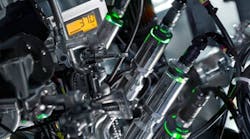In the pharma industry, there is a growing pressure to combat global health challenges with greater speed, accuracy and impact.
As a result, many pharma organizations are looking to create future-ready ‘next-gen’ labs to drive medical breakthroughs. This will involve rethinking their entire approach to lab structure and operation, increasing emphasis on digitalization, AI, workforce skills and culture.
While many are keen to capitalize on the benefits offered by nextgen labs, transformation is not a swift process. Our recent survey of pharma execs found that nearly half of organizations anticipate that they will require two to five years to transform labs.
While most enterprises are still in the early stages of transformation, leaders must prepare to confront challenges in data, technology, people and processes to achieve longterm success.
Enabling next-gen labs
As the market shifts towards advanced drug production, there are several essential elements to consider.
Firstly, to enable next-gen labs, organizations must have the correct architecture and systems integration in place. This includes enabling the necessary systems, instruments, data protocols and physical and digital architecture. What’s further, leaders should evaluate both cutting-edge and sustainable design options, which lower carbon footprint and increase energy efficiency.
Intelligent data capture and reporting is also essential. Data and analytics can be leveraged in labs to terminate poor drug candidates early and reduce late-stage failures. By implementing new technologies that make data collection more intelligent and analytical in nature, organizations can achieve faster, more accurate reporting.
With architecture and data capture capabilities in place, the next step is to simplify and digitize workflows. In many existing lab ecosystems, personnel are utilizing analog methods of communication, resulting in lost data, transcription errors, translation mistakes and misinformation. By optimizing workflows in digital systems, communication becomes more seamless, resulting in less human error and a more agile workforce.
Discovery acceleration is the final piece of the puzzle. This involves applying innovative technologies, such as AI and ML, to speed up data capture.
Gearing up for transformation
Once an organization has put the pieces in place to enable transformation, there are several guidelines for success:
• Build for adoption: From an early stage, involve end users, scientists and lab technicians.
• Develop incrementally: Starting with pilot projects builds momentum. Leaders should create an agile project management strategy to divide the program into smaller projects, meeting milestones incrementally while sharing achievements with stakeholders.
• Deploy changes with agility: Adopting a ‘fail-fast’ momentum will help encourage adoption from scientists and technicians. Engaging personnel with minimal disruption to day-today activities will require agility from project managers.
• Safeguard investments: Regardless of how a transformation evolves, it’s crucial for labs to protect the investments that have been made, improving ROI across their line of operations.
• Infuse scientific talent into IT projects: Integrating lab practitioners into data science, system integrations, and other transformation initiatives will enhance lab transformation.
Leveraging innovative technology is also important. For example, adapting generative AI and large language models in R&D can streamline structure elucidation, toxicity testing and experiment design, while AI and natural language processing models can be used for CMC documentation, product quality reports, and lab experiment analysis.
Leaders who do not prepare their businesses to take on this level of change will inevitably fail. Next-gen labs are the key to unlocking the full potential of scientific exploration and drug discovery. But without the correct tools, technologies and culture in place, the benefits offered by these labs can never fully be realized.






